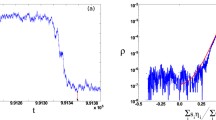Abstract
We investigate the propagation of random fluctuations through biochemical networks in which the number of molecules of each species is large enough so that the concentrations are well modeled by differential equations. We study the effect of network topology on the emergent properties of the reaction system by characterizing the behavior of variance as fluctuations propagate down chains and studying the effect of side chains and feedback loops. We also investigate the asymptotic behavior of the system as one reaction becomes fast relative to the others.
Similar content being viewed by others
References
Anderson, D.F., 2005. Stochastic perturbations of biochemical reaction systems, Duke University Thesis.
Anderson, D.F., Mattingly, J.C., 2007. Propagation of fluctuations in biochemical systems II: nonlinear chains, submitted.
Ball, K., Kurtz, T., Popovic, L., Rempala, G., 2006. Asymptotic analysis of multiscale approximations to reaction networks. Ann. Appl. Probab. 16(4), 1925–1961.
Crabtree, B., Newsholme, E.A., 1985. A quantitative approach to metabolic control. In: Current Topics in Cellular Regulation, pp. 21–76. Academic, San Diego.
Delbruck, M., 1940. Statistical fluctuations in autocatalytic reactions. J. Chem. Phys. 8, 120–124.
Feinberg, M., 1979. Lectures on chemical reaction networks; delivered at the Mathematics Research Center, Univ. Wisconsin–Madison.
Feinberg, M., 1987. Chemical reaction network structure and the stability of complex isothermal reactors—I. The deficiency zero and deficiency one theorems, Review article 25. Chem. Eng. Sci. 42, 2229–2268.
Gadgil, C., Othmer, H., Lee, C.H., 2005. A stochastic analysis of chemical first-order reaction networks. Bull. Math. Biol. 67, 901–946.
Gans, P.J. (1960). Open first-order stochastic processes. J. Chem. Phys. 33(3), 691.
Gillespie, D.T., 1976. A general method for numerically simulating the stochastic time evolution of coupled chemical reactions. J. Comput. Phys. 22, 403–434.
Heinrich, R., Rapoport, T.A., 1974. A linear steady-state treatment of enzymatic chains General properties control and effector strength. Eur. J. Biochem. 42, 89–95.
Horn, F.J.M., Jackson, R., 1972. General mass action kinetics. Arch. Rat. Mech. Anal. 47, 81–116.
Kacser, H., Burns, J.A., 1973. The control of flux. Symp. Soc. Exp. Biol., 27, 65–104.
Kurtz, T., 1972. The relationship between stochastic and deterministic models for chemical reactions. J. Chem. Phys. 57(7), 2976–2978.
Nijhout, F., Reed, M., Budu, P., Ulrich, C., 2004. A mathematical model of the folate cycle—new insights into folate homeostasis. J. Biol. Chem. 279(53), 55008–55016.
Nijhout, F., Reed, M., James, J., Anderson, D., Mattingly, J.C., Ulrich, C., 2006a. Long-range allosteric interactions between the folate and methionine cycles stabilize DNA methylation reaction rate. Epigenetics 1, 81–87.
Nijhout, H.F., Reed, M.C., Shane, B., Gregory, J.F., Ulrich, C.M., 2006b. In silico experimentation with a model of hepatic mitochondrial folate metabolism. Theor. Biol. Med. Model. 3, 40–56.
Oksendal, B., 2003. Stochastic Differential Equations: An Introduction with Applications, 6th edn. Springer, Berlin.
Reed, M., Nijhout, F., Sparks, R., Ulrich, C., 2004. A mathematical model of the methionine cycle. J. Theor. Biol. 226, 33–43.
Reed, M.C., Nijhout, H.F., Neuhouser, M.L., Gregory, J.F., III, Shane, B., James, S.J., Boynton, A., Ulrich, C.M., 2006. A mathematical model gives insights into nutritional and genetic aspects of folate-mediated one-carbon metabolism. J. Nutr. 136, 2653–2661.
Westerhoff, H.V., Chen, Y.-D., 1984. How do enzyme activities control metabolite concentrations? An additional theorem in the theory of metabolic control. Eur. J. Biochem. 142, 425–430.
Author information
Authors and Affiliations
Corresponding author
Rights and permissions
About this article
Cite this article
Anderson, D.F., Mattingly, J.C., Nijhout, H.F. et al. Propagation of Fluctuations in Biochemical Systems, I: Linear SSC Networks. Bull. Math. Biol. 69, 1791–1813 (2007). https://doi.org/10.1007/s11538-007-9192-2
Received:
Accepted:
Published:
Issue Date:
DOI: https://doi.org/10.1007/s11538-007-9192-2




